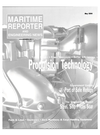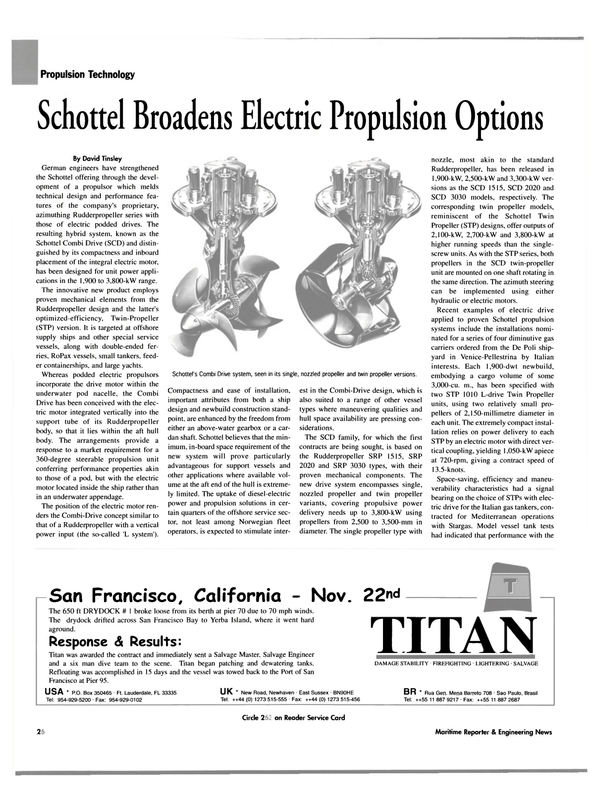
Waterjets for a Difficult Design Task
The idea of a ferry going over the sea to Skye is not a new one, although with the Skye bridge opening a few years ago. it is not an adventure many people undertake these days. A small car ferry operates in the south of the island, and a large car ferry takes people over from Uig in the north west corner of Skye to the Outer Hebridian islands of Lewis and Barra. There had however, long been talk of a possible passenger service linking the North of Skye to the Scottish mainland at Gairloch. A feasibility study was carried out by the local council, after which some local businessmen pulled together to form a new company in 2003 called West Highland Seaways Ltd.. trading as 6° West.
The requirement to make the route successful was that the journey must be done four times per day, in an hour and a half, requiring an average speed of 18 knots. The journey must be comfortable, but in a craft that could handle the rough sea conditions. While existing designs were offered with modifications to meet the new EU regulations on the safety of Passenger Vessels, they tended to be relatively heavy displacement vessels, which required excessive power and fuel consumption to achieve the 18 knots required.
Ace Marine were approached, and responded with a new concept in boat design that was designed to be low cost, lightweight and comfortable, with reconditioned airline seats. The designer molded a relatively narrow hard chine planing hull form around six rows of seats with the intention of delivering excellent sea keeping qualities, both at speed, and at loitering speeds.
The client specified a pair of Cummins engines for redundancy. The 26-in.
diameter propellers required to push the vessel at 18-20 knots meant long shafts with brackets, and exposed rudders. In order to protect the propellers and rudders for beaching purposes, the designer added a long and deep sloping keel. The whole effect was unsatisfactory. Waterjets were investigated and the initial findings were not encouraging. They appeared expensive and inefficient below 25 knots.
However, the designer found Ultrajet units, which met price and performance requirements.
The vessel was designed in 3-D using Maxsurf Pro from formation design, with hydrostatics, damage stability, and one compartment flooding checked with Hydromax Pro. All plates were defined without recourse to complex curvature, and developed using Workshop.
The dxf plate outlines were then sent to the yard, where they were nested and then cut using their CNC plasma cutter. The vessel was being built at Sandy Morrison Engineering in Uig, Isle of Skye, was scheduled for delivery this month.
Circle 22 on Reader Service Card
Read Waterjets for a Difficult Design Task in Pdf, Flash or Html5 edition of May 2004 Maritime Reporter
Other stories from May 2004 issue
Content
- Fincantieri Delivers Westerdam page: 10
- "World's Largest" Heavy Lift Ship Enters Service page: 10
- Damen Delivers Pair of Tugs page: 10
- Not Just Another Dam Ship page: 12
- Welsh Towing Company Growth Continues page: 14
- Gladding-Hearn Starts Construction of New I neat Vessel page: 15
- Despite 11% Increase, Hempel Disappoints page: 15
- Grimaldi-Naples Receives GM Award page: 16
- Schlueter Promoted to VP page: 17
- Misplacing the Place of Refuge page: 20
- Schottel Broadens Electric Propulsion Options page: 26
- CIMAC Congress Set for Kyoto page: 29
- Waterjets for a Difficult Design Task page: 30
- New Shaft Seal from Ocean Venture Seals page: 31
- Gas Turbines: Keeping Fresh With Innovation page: 32
- MAN B&W Diesel Debuts the New S65ME-C page: 33
- Thordon COMPAC Finds Success in FSV page: 33
- Wartsila to Power Australian FPSO page: 34
- VSP: Same Power, 9% More Bollard Pull page: 35
- The New MTU 2000 CR Marine Engines page: 36
- Converting and Repowering One Very Big Ship page: 38
- Power for a New Breed of RoPax page: 40
- ZF Helps to Harness Spirit of Ontario's Power page: 41
- Greece Poised for Posidonia 2004 page: 42
- Leif Hoegh Records Strong First Quarter page: 43
- BV Launches LNG CAP page: 43
- Steel, Ship Prices Soar as Tankers Stay Firm page: 44
- Ice Class & Large Ships Pose New Challenges page: 44
- Royal Caribbean Stays Current with C-MAP CM-93/3 ECs page: 46
- JRC Proposes Integrated Nautical Safety System page: 46
- C-Map's RTU and the Ending of the Paper Trail page: 47
- AutoChief C20 Reports Good Market Penetration page: 48
- Vision FT IBS page: 48
- Research Winches for R/V Maria S. Merian page: 52
- Konecranes Giving Port Efficiency a Lift page: 52
- Chinese Yard Logs Strong Month page: 55
- Fuel Oil Separation Takes Center Stage page: 56
- Security of Ports and Vessels: A New Approach page: 60


